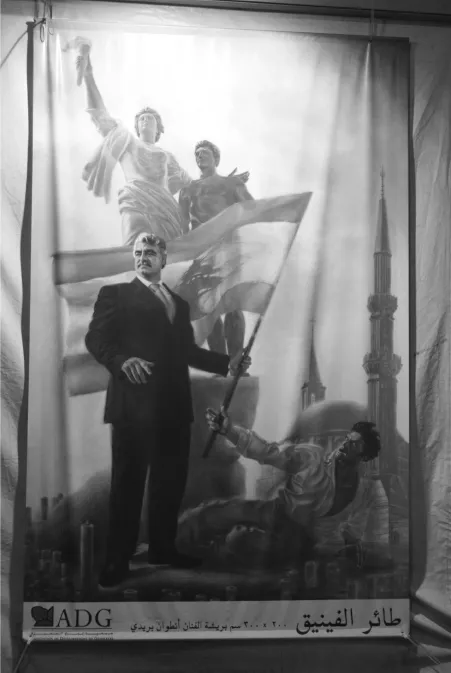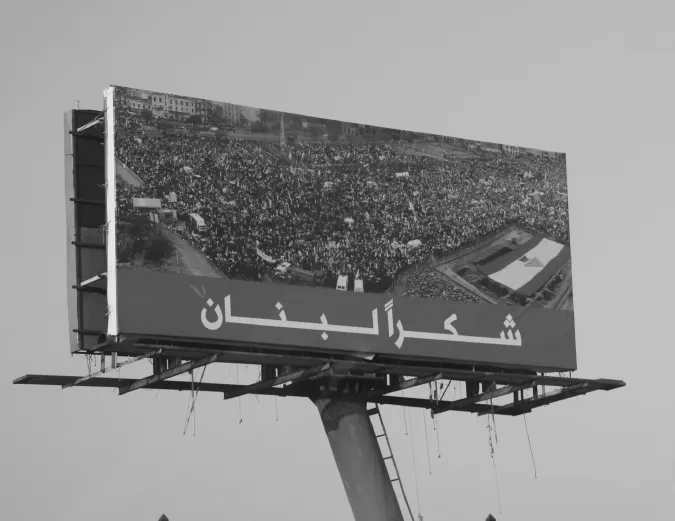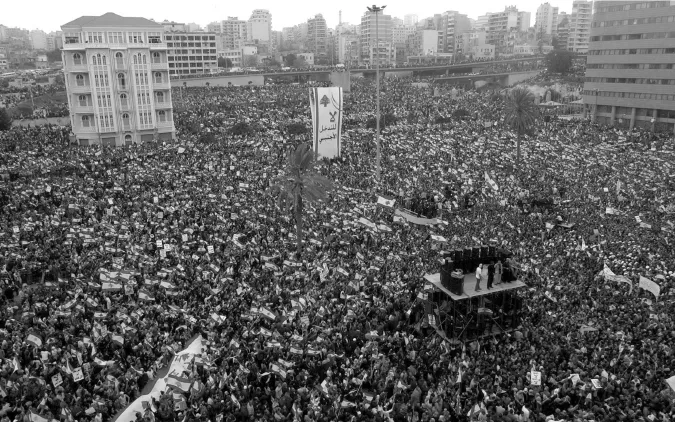![]()
PART I
REVOLUTIONARY ILLUSIONS
![]()
1
The Visual Legacy of the Cedar Revolution in Lebanon
The assassination of former Prime Minister Rafic Hariri on 14 February 2005 was a visual landmark for Lebanon. It catalyzed a series of public rallies in downtown Beirut calling for the withdrawal of Syrian troops from Lebanese soil, culminating in the establishment of two rival Lebanese political blocs, pro-Syrian March 8 and anti-Syrian March 14, and an image war between them. Image-conscious rallies were vital visual communicators of political stance during what came to be known as the Cedar Revolution, paving the way for a new era in Lebanese politics marked by the heightening of the role of the visual.
Prior to 2005, the visual in Lebanese politics had seen its manifestation mainly through the use of political posters, which different factions used to commemorate their martyrs and deeds, and to demark territory.1 As Sune Haugbolle observes, since the days of the Lebanese Civil War (and even before), geographical zones in Lebanon have been visually marked through the presence of posters (as well as other public space markers like graffiti) belonging to particular groups, transforming those zones into “pure” “Hizbullah,” “Kataeb,” “Amal” or “Progressive Socialist Party” areas, while excluding “others.”2 Posters in Lebanon thus perform the role of symbolic, sectarian, political and physical boundary markers. This process of multiple exclusions can be read as a product of the “fragmentation of the social into a multiplicity of hegemonic formations” in Lebanon, whereby there is no centralized hegemonic force, but where, instead, each political-sectarian group constitutes its own “regime of truth.”3
Hariri’s assassination magnified this dynamic but also added to it new visual political formations. This chapter discusses the three main roles that the image has been playing in Lebanese politics since the Cedar Revolution: as a marker of political identity, as a political rallying tool and as a weapon against political rivals. The chapter argues that the importance of the Cedar Revolution in Lebanon lies in how it catalyzed a new style of politics in the Middle East that is marked by deliberate visual saturation.
The image as a political identity marker
The assassination of Hariri almost immediately created public markers for two rival political communities in Lebanon: Hizbullah and its allies, who were pro-Syrian, and who came to be known as the March 8 coalition, and Hariri’s own Future Movement and its allies, the March 14 coalition, who believed that Syria was behind the assassination and called for the withdrawal of Syrian troops from Lebanon through the implementation of UN Resolution 1559, in addition to establishing a tribunal investigating the assassination. The rivalry between the two coalitions was played out both in the media and in public space, as they both attempted to present themselves as political blocs driven by wide popular support. This political competition resulted in the production of images acting as political identity markers both for the coalitions themselves and their followers.
Perhaps the first key image created through this competition was that of Rafic Hariri himself. Before his assassination, Hariri personified the “Big Man” style of political leadership, “characterized by authority derived from personal efforts and abilities through the allocation and reallocation of private resources.”4 Well before becoming Prime Minister, Hariri’s clout was established as a result of his economic and philanthropic work in Lebanon that he funded through wealth accumulated while he worked as an ultra-successful businessman in Saudi Arabia. Hariri channelled his personal resources, mainly his economic capital and his high-profile international contacts, into a rising profile as a political player in Lebanon, which was cemented with the role he played in brokering the Taef Agreement in 1989 that ended the Lebanese Civil War. After his assassination, his political party and its allies sought to transform his image into an icon. Betsky et al. argue that icons act as anchors of meaning in a world of continual change.5 With uncertainty shaking the Lebanese street, both in terms of who might have been responsible for the assassination and where the country would be headed afterwards, Hariri as an icon served to ground the political demands of his party and its allies and reassure their supporters. This icon stood for freedom, justice and development. A photo book produced by Dar Annahar in 2005 titled The Beirut Spring, to commemorate the popular uprising catalyzed by Hariri’s death, presented Hariri as “the martyr of the nation.” Photos of Hariri appeared all over Beirut, coupled with slogans inciting people to action. “I leave in God’s will this beloved country [in your custody],” declared one poster. As such, Hariri the icon was calling on people to continue his legacy.
People responded to this political call in February 2005 by taking to the streets to commemorate his death, meeting every Monday in downtown Beirut while wearing t-shirts bearing his image or carrying his photos, and calling for the truth behind his assassination to be found. They eventually settled in Martyrs’ Square, where Hariri was buried, creating a protest camp calling for the resignation of the pro-Syrian government. Future Television, the channel owned by Hariri, suspended its normal schedule to dedicate full-time coverage to Hariri’s assassination and its aftermath. Several programs about his philanthropy, development work in Lebanon and political achievements were aired, in which Hariri was framed as a man of the people who gained the respect of world leaders.
Hariri’s grave became an additional landmark in downtown Beirut. Situated next to the grand al-Amin mosque that Rafic Hariri had been building in Martyrs’ Square, the grave itself is housed within a large tent transforming the place into at once a shrine for Hariri as well as a space for the communication of political messages. The grave-as-shrine is heavily reliant on visual imagery: It displays the last photos taken of Hariri alive, and in a nearby street, “footprints” are installed in the ground in downtown Beirut chronicling his last walk in the area. A large painting by Antoine Braidy on one side of the grave tent titled “The Phoenix” embeds Hariri in the iconic Martyrs’ Square statue, and depicts the statue’s martyrs alive, with one of them handing over the Lebanese flag to Hariri, thus marking him as the carrier of the legacy of those who died for Lebanon, and entering the country’s national mythology. The space also utilizes intertextuality to frame Hariri as a popular leader. Above the grave, a large panoramic collage shows photos of Hariri’s family as well as ordinary people clad in black, crying and praying on the day of his funeral.
The grave-as-political communicator has its messages communicated through posters that are frequently changed to comment on the political situation of the present moment. After the withdrawal of Syrian troops from Lebanon following the mass rallies protesting
Fig. 2. Painting by Antoine Braidy at Rafic Hariri’s grave in downtown Beirut.
Hariri’s death, the grave tent had on one side a banner with Hariri’s photo and the words: “With you: He taught, he built, he liberated,” referencing Hariri’s education foundation and his effort to rebuild Lebanon’s infrastructure after the civil war, and crediting him with posthumously liberating the country from Syria. The slogan was a message directed at Hizbullah, which had laid a monopoly over the label “liberation” as it applied it solely to its own effort to liberate Lebanon from Israel, which culminated in the withdrawal of Israeli troops in 2000 after almost two decades of occupying southern Lebanon. Another banner at the gravesite shows a photo of the mass gathering in Martyrs’ Square on the day of Hariri’s funeral, with the slogan “They feared you so they killed you.” A stone plaque at the site is carved with the words “For the sake of Lebanon,” and next to it official documents from the Special Tribunal for Lebanon set up by the United Nations to investigate Hariri’s murder are displayed, a direct message about Hariri’s supporters’ not giving up on this cause.
For three weeks after Hariri’s death, his rivals watched both the growing mass rallies in downtown Beirut and the pro-Hariri broadcasts on Future Television. They responded by organizing a mass rally of their own on 8 March 2005, in which people declared their allegiance to Syria yet also called for the truth behind Hariri’s assassination to be found, thereby appropriating the image of the pro-Hariri Monday gatherings. This appropriation also took the form of declared patriotism. The Hariri supporters had used the Lebanese flag as a visual marker, signaling Hariri’s contribution to Lebanon, but also framing their political demand as being in the country’s interest. The March 8 protest saw a similar use of the Lebanese flag, framing the political demand of maintaining ties with Syria in their existing form as being in the interest of Lebanon. The flag, then, became a contested visual marker of a claimed national cause.
Fig. 3. A billboard on the road to southern Lebanon depicting the 14 March 2005 demonstration in downtown Beirut and the caption “Thank you, Lebanon.” Photo taken on 31 August 2008.
The use of the Lebanese flag by Hariri’s supporters was part of a process of value definition that first established core values (freedom, sovereignty, independence), and then aggregated those values under one national symbol.6 But the flag was also part of the creation of what Assem Nasr calls a “Lebanese identity brand.”7 This brand was about Lebanon as a cosmopolitan, life-loving, unified country, and its visual expression was seen in political advertisements on television as well as in images and paraphernalia that started emerging after Hariri’s camp organized a rival mass rally on 14 March 2005, which lent the political coalition its name. The March 14 rally resembled a carnival8 where the Lebanese flag became an embodied marker, worn by people as a scarf, a hat or a cape, drawn on their faces and bodies, and embedded in various items of clothing and accessories. Political declarations thus merged with patriotic ones and became a fashion statement.9
The flag also appeared on merchandise that was being sold in downtown Beirut, from personal accessories to food. Those objects became quotidian communicators of political identity. This process was not accidental; March 14’s public rally was in part due to the utilization of a public relations company, Quantum Communications, which designed the logos, slogans and objects used on the day of the demonstration, branding it “Independence ’05.” Red was the background color of choice for the objects carrying this slogan, which was written in white, a direct reference to the colors of the Lebanese flag. Barak argues that this appropriation of national symbols served as a challenge to pro-Syrian state leaders, who were “referred to as part of the ‘security regime’ or ‘security network’ that usurped the country and the political society.”10 The 14th of March, then, can be seen as the day that marked the transformation of Lebanese politics into “merchandised politics.”11
Fig. 4. March 8 demonstration in downtown Beirut in 2005. Photo by Assafir.
This merchandised politics is built on an ideology of consumption that was embodied in the paraphernalia; a citizen could literally “consume” the objects on sale. This consumption of objects can be located within a wider framework that has dominated Lebanon since the end of the civil war. As Nasr argues,
Consumption emerges as a form of resistance for the people of Lebanon to the direction in which their country is heading: further conflict and turmoil. Accumulating items, such as clothing, cars . . . etc., which gives us the illusion of living in a cosmopolitan sphere, is the only vehicle to overcome the forces that hinder our development and unity as a nation.12
Future Television built on this framework though airing publicity videos encouraging the Lebanese people to shop as a show of support for the Lebanese economy.
As such, the publicity was also encouraging the simultaneous production and consumption of signs in everyday life. Citizens were to consume the publicity messages, and in turn, engage in the act of shopping as a symbolic patriotic act akin to participating in public rallies. Lefebvre argues that publicity “is based on the imaginary existence of things; it evokes them and involves a rhetoric and a poetry superimposed on the art of consuming and inherent in its image; a rhetoric that is not restricted to language but invades experience.”13 The Lebanese were encouraged to become “prosumers,”14 producing and consuming patriotism, national unity and a stable economy as signs in their daily experience. But this hyperreality15 rendered their performance of patriotism, through participating in public rallies and consuming national signs, a form of mimicry16: People shaped their daily behavior to resemble that of patriotic citizens. It was as if Lebanon were a country marked by national unity. This was seen most acutely in the proliferation of symbols about sectarian harmony.
Participants in the public rallies often carried a cross and a Quran together, or painted the images of those religious symbols on their cheeks or bought an intertwined crescent and cross on a string from one of the market stalls set up in Martyrs’ Square to wear as a necklace. The media also focused on those images, zooming in their cameras on nuns and sheikhs praying together at Hariri’s grave in Martyrs’ Square. This communicative activity, both the actua...



